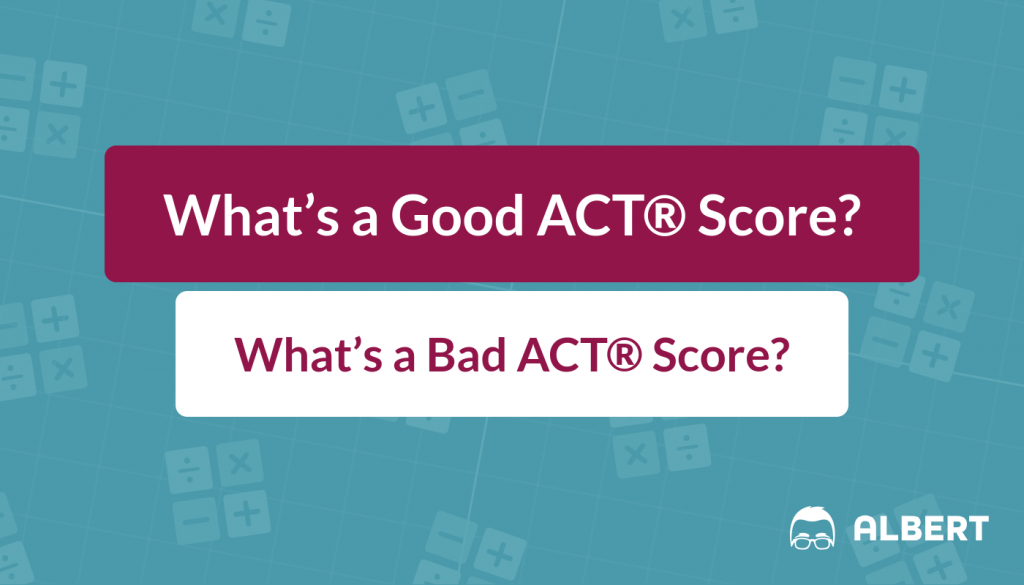What is an ACT® score? Well, until recently, the SAT® was the test to take to qualify for college admissions. It has been administered consistently since the 1920’s and is considered a staple in American culture, and is even a rite of passage to some. However, as American views on education continued to develop, many felt as though the SAT® was out of touch with students and their needs.
So, in 1959, the ACT® program was born. ACT® is an abbreviation for American College Test and was started by a professor in Iowa who was dissatisfied with the SAT® testing format and procedures.
The ACT® is meant to be an assessment test. That means it only tests what you’ve learned in school, not how you think. It’s been growing in popularity since its introduction and is thought to soon overtake the SAT®, if it hasn’t already, in its number of annual test takers. You can read about that here.
Because of the ACT®’s relative newness, it can be hard for students, parents, and teachers alike to determine what good and bad ACT® scores are.
But you don’t need to worry because we’ve got you covered.
Many different elements can determine a “good” score on the ACT®. Below, you’ll find a list of all of them.
The higher the better

The highest score you can get on the ACT® is a 36. To earn this score, you must achieve 35’s and 36’s in the four subsections. English, Math, Reading, and Science. The writing test is optional and does not affect your “composite” score.
How is the ACT® Scored?
The grading machine takes how many answers you got right on each section and scales them to a score between 1-36.
Here’s an example:
| English Raw Score |
Mathematics Raw Score |
Reading Raw Score |
Science Raw Score |
Scaled Score |
| 75 | 60 | 40 | 40 | 36 |
| 73-74 | 59 | 39 | 39 | 35 |
| 71-72 | 58 | 38 | – | 34 |
| 70 | 56-57 | 37 | 38 | 33 |
| 69 | 55 | 36 | 37 | 32 |
| 67-68 | 54 | 35 | – | 31 |
| 66 | 52-53 | 34 | 36 | 30 |
| 65 | 50-51 | 32-33 | 35 | 29 |
| 63-64 | 48-49 | 31 | 33-34 | 28 |
| 62 | 45-47 | 30 | 32 | 27 |
| 60-61 | 42-44 | 29 | 30-31 | 26 |
| 58-59 | 40-41 | 27-28 | 28-29 | 25 |
| 56-57 | 37-39 | 26 | 26-27 | 24 |
| 54-55 | 35-36 | 24-25 | 25 | 23 |
| 52-53 | 33-34 | 23 | 23-24 | 22 |
| 49-51 | 31-32 | 22 | 21-22 | 21 |
| 46-48 | 29-30 | 20-21 | 19-20 | 20 |
| 43-45 | 26-28 | 19 | 18 | 19 |
| 41-42 | 24-25 | 18 | 16-17 | 18 |
| 39-40 | 21-23 | 16-17 | 15 | 17 |
| 36-38 | 17-20 | 15 | 14 | 16 |
| 33-35 | 14-16 | 14 | 13 | 15 |
| 30-32 | 11-13 | 12-13 | 12 | 14 |
| 28-29 | 9-10 | 11 | 11 | 13 |
| 26-27 | 7-8 | 9-10 | 10 | 12 |
| 24-25 | 6 | 8 | 9 | 11 |
| 22-23 | 5 | 6-7 | 7-8 | 10 |
| 20-21 | 4 | – | 6 | 9 |
| 17-19 | 3 | 5 | 5 | 8 |
| 14-16 | – | 4 | 4 | 7 |
| 11-13 | 2 | 3 | 3 | 6 |
| 8-10 | – | – | – | 5 |
| 6-7 | 1 | 2 | 2 | 4 |
| 4-5 | – | – | 1 | 3 |
| 3 | – | 1 | – | 2 |
| 0-2 | 0 | 0 | 0 | 1 |
Source: The Real ACT® Study Guide
So, as you can see, the exam looks at your correct answers X/75 for English, X/60 for math, and X/40 for reading and science. Then, based on the performance of your peers, scales the scores over to the more familiar 1-36.
These scores are individually reported and colleges tend to take them all into consideration. This means that if you scored in the 30’s in everything but science, it could be a handicap to your application.
Finally, the test takes the four scores and averages them.
So, A + B +C +D / 4 = your score.
Fractions that are lower than one-half are rounded down; fractions one-half or higher are rounded up.
Unfortunately, few students will achieve the perfect 36. In fact, the national average for 2015 was only 21.
Take a look:
| English | 20.3 |
| Math | 20.9 |
| Reading | 21.3 |
| Science | 20.8 |
| Composite | 21.0 |
Technically, anything above the national average of 21 can be considered a “good” ACT® score, as long as it gets you into the school of your choice.
So What Does This Mean for You?
Obviously, you want your ACT® score to be the highest that it can be. You also want to have a consistent performance throughout the four categories. That is, it would look bizarre to colleges if you scored a 36 in math and a 21 in science.
Also, because of how the score averages work in determining your composite score, your extremely low score would practically cancel out your perfect one. So, if you know one subject will be particularly tricky for you, make sure to allocate more study time so that your scores will be on consistent across the board. This doesn’t mean that you should get the same score on each section, but since colleges are looking for well-rounded students who are capable of doing a variety of work, it’s best to get them as close as possible.
How Does the ACT® Affect my College Application?
This is where what constitutes a “good” ACT® score becomes extremely relative. It depends on what kind of school you want to go to.
If you are looking into a school that is selective and has a highly competitive admissions process, like an Ivy League school, Stanford, Rice, etc., then you will need ACT® scores that are well above the national average. Really, you need to score 33 or higher on each section.
But, maybe you aren’t as interested in those highly competitive schools. Maybe you want to go to a larger university like Baylor, a liberal arts school like Rollins College, or maybe even a state school close to home. If that’s the case, a good ACT® score is one that puts you in the top 25% of that respective school’s applicants.
Let us break that down for you:
When you take the exam, whether for the first, second, or third time, you need to go into the test with a target ACT® score range. For example, “On the April ACT®, I will score between 31-33 on each of the four sections.”
Now, maybe you don’t need to score that high. What’s important is that your scores are competitive for the school that you want to go to.
The first step is to make a list of the schools you are interested in attending. If you aren’t sure what kind of school you want to go to quite yet, pick a state school and private university near where you live and start from there.
Then, you’ll then want to create a table that looks something like this:
| School Name | 25th Percentile | 75th Percentile |
| Boston University | 26 | 30 |
| Mount Holyoke College | 27 | 31 |
| UMass Amherst | 24 | 29 |
After you’ve inserted the names of your favorite schools, you will want to do a quick internet search for their average test scores. So for Boston University, you would look up “average ACT® scores Boston University.” In your results, you should find the 25th and 75th percentile score ranges for each school.
The 25th percentile means that students who report these scores are only better than 25% of their classmates. In other words, they are the bottom of the class. If you score in this range, you will need to compensate in other areas of your application. Meaning that if you have low ACT® scores, you’ll need a fantastic personal statement, a great GPA, and stellar teacher recommendations.
The 75th percentile means that students who fall in this ACT® score range are better than 75% of their classmate. To have a good chance of being admitted, you need to make sure that your scores fall into the 75th percentile or higher.
What if You’ve Already Taken the ACT® and Don’t Want to Take it Again?
Unless you scored a perfect 36 taking the ACT® multiple times is usually in your best interest. There is always room for improvement! However, perhaps you’re a senior and application deadlines are quickly approaching. You need to know where you can apply with the scores you have now.
You should start with a quick search of “schools that accept X ACT® score” or, you can visit this list and see where you fit in.
Are You In Need Scholarship Money?
If so, a high ACT® score can work in your favor. In this case, a good ACT® score is one that earns you the financial aid that you need, although as usual, the higher the score, the better the scholarship.
You can find these scholarships directly on colleges’ websites, or from third party websites like this one. Typically, to receive scholarships from third parties, you will need to score in the 75th percentile or higher on the ACT®. However, most colleges do offer financial or need-based for scores lower than this, often in the form of a grid or calculator on their website. That is, if you earned X on the ACT®, you are given Y in scholarship money. These score ranges are normally very cut and dry, meaning that there are no exceptions.
What Do You Want to Major in?
The field that you want to go into also affects what a good ACT® score is for you. For example, if you want to go into the engineering field, then you will need to have higher math scores. It is also essential that your scores are on par with what that college requires. Often, low scores will bar you from entering a certain major within the school, even if you qualify for the school in general.
If you are going into the humanities field, then your math scores can be anywhere from 3 to 5 points lower than the recommended score, and you will still be considered a viable candidate for admission. However, your verbal scores will need to be higher to highlight your strengths.
Key Takeaway When Answering, “What is a Good ACT® Score?”
Please remember that ACT® scores are not the only piece of the college admission puzzle. Your grade point average, club participation, volunteer experience, essays, and teacher recommendations will also heavily impact how the admissions committee views you.
Also, keep in mind that your ACT® scores do not define you, so if your scores are not where you want them to be, then do not worry. You can always retake the test.
Looking for ACT® practice?
Kickstart your ACT® prep with Albert. Start your AP® exam prep today.








